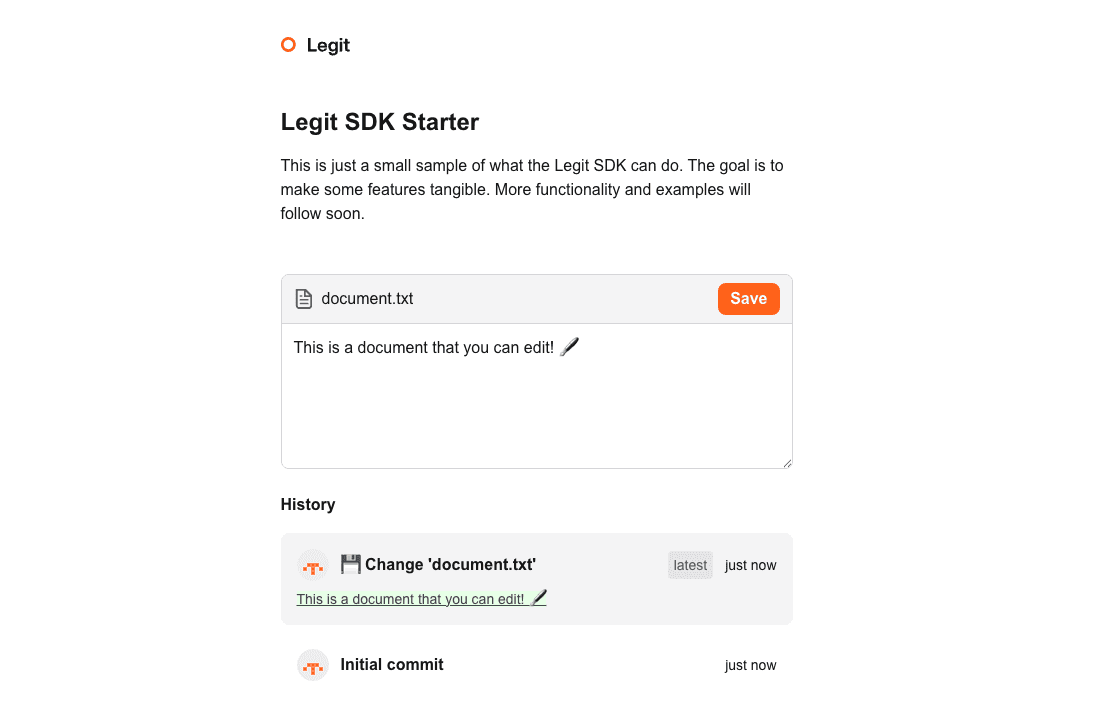Legit SDK Starter Example
What this example shows
This is the first minimal starter for the Legit SDK, built with zero abstraction to show how LegitFS really works under the hood. It just shows a small sample of what the Legit SDK can do. The goal is to make some features tangible. More functionality and examples will follow soon.
It’s designed to be your hands-on introduction to the SDK’s core principle:
“Every write is versioned, every state is recoverable.”
You can explore the live version here: 👉 starter.legitcontrol.com
And the repository here: 👉 legit-starter

It runs in the browser, backed by an in-memory filesystem (memfs) and the Legit SDK, showing how you can:
- Initialize a LegitFS instance
- Write versioned files
- Read commit history
- Explore diffs between versions
- Roll back or inspect previous states
This is a minimal proof of concept. More examples — including collaborative, persistent, and AI-integrated scenarios — will follow soon.
What’s happening under the hood
Let’s walk through what the starter does, step by step.
1. Initialization
When the app loads, it creates a LegitFS instance using memfs as the storage layer:
const legitFs = await initLegitFs(fs, "/");Then it writes a simple file (document.txt) into the main branch:
await legitFs.promises.writeFile(
"/.legit/branches/main/document.txt",
"This is a document that you can edit! 🖋️"
);From here on, every write to this file becomes part of a versioned history (no manual commits needed).
2. File editing and saving
The editor in the UI simply modifies the working copy of the file. When you hit Save, Legit automatically commits a new version.
You can see this in the code:
await legitFs.promises.writeFile(`/.legit/branches/main/${FILE_NAME}`, text);This triggers Legit’s internal logic to:
- Detect changes
- Create a new commit
- Update the branch
HEAD - Write history to
.legit/branches/main/.legit/history
3. Reading commit history
The example periodically reads the branch’s history file:
const raw = await legitFs.promises.readFile(
"/.legit/branches/main/.legit/history",
"utf8"
);
const parsed: HistoryItem[] = JSON.parse(raw);Each HistoryItem includes:
oid: the commit hashparent: previous commit(s)author,message, andtimestamp
That data drives the “History” list in the UI.
4. Inspecting and comparing commits
Each commit stores its own snapshot under .legit/commits.
You can read any past version directly:
await legitFs.promises.readFile(
`/.legit/commits/${oid.slice(0, 2)}/${oid.slice(2)}/document.txt`,
"utf8"
);The demo uses this to render a semantic diff between commits with diff-match-patch-ts .
5. Polling for changes
The app polls the .legit/branches/main/.legit/head file every few milliseconds to detect when new commits appear — keeping the editor and history list synced automatically.
This works because reading .legit/head is very cheap, even in fast intervals.
What to take away
The goal of this starter is not to show a UI pattern — it’s to demonstrate LegitFS as a concept:
- It behaves like a regular
fsAPI - It version-controls all writes automatically
- It keeps state in a
.legitstructure that’s easy to inspect - It works fully in-memory (no backend required)
This “zero-abstraction” design lets you understand exactly what happens behind each operation. Ideal for learning, debugging, and early prototyping.
Related Reading
If you haven’t yet, check out these sections for deeper context:
- Getting Started with Legit SDK — how to install and initialize LegitFS
- Filesystem API — all about initLegitFs, .promises, and how history is stored
- The Filesystem Concept — why Legit uses the filesystem as the universal interface
- The Idea — why Git’s core principles matter for AI and collaboration
Feedback
We’re sharing this early because we want your feedback. If you tried the starter or built on top of it, tell us:
- Was the setup and mental model clear?
- What felt confusing or fragile?
- What other examples would you like to see?
Join the discussion in #feedback on Discord .